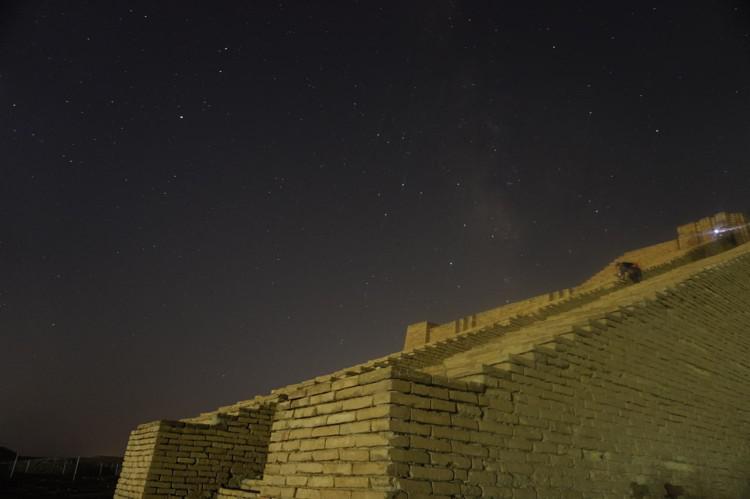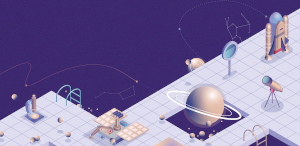This page describes an image Galaxy Arm
Image caption:
Honourable mention in the 2022 IAU OAE Astrophotography Contest, category Still images of celestial patterns.
Taken from the south of Iraq in January 2022, this image shows a clear sky over one of the many ancient monuments in the region which looks like a Babylonian ziggurat. The Sumerians had invented these mountain-like buildings even before the invention of script; the earliest ziggurats appear around 4000 years before the common era. They look like the frustum of a pyramid and in Babylonian times often had temples on top. Next to the stairs of the ziggurat are the constellations of the southernmost part of the Zodiac, also invented in Babylon. Today, we call them Capricorn (left, with a planet in it) and Sagittarius, whose brightest stars form the asterism of the Teapot. For the Babylonians, Sagittarius was the god Pabilsang, the city god of Larak and a god of agriculture and war. He was also the husband of the mighty goddess of medicine, Gula, and his iconography is a hybrid creature holding a bow and arrow: a male human torso and head attached to the body of a horse with four legs, two gigantic wings and two tails — a horse tail and a scorpion tail. Such a creature did not exist in Greek mythology, so the Greeks reduced it to something they knew, a centaur holding a bow and arrow. This picture still did not make sense in Greek culture because centaurs were considered wild and cruel, and not intelligent enough to use a bow and arrow. Therefore, there was another Greek figure that existed simultaneously: a man with hooves instead of feet at the ends of his legs, a satyr, but this figure vanished in Roman times.
Capricornus is one of the most stable foreign creatures in the Zodiac and has been unchanged over millennia. It is depicted as a hybrid creature with the front part of a goat and the back part of a fish. This so-called Goat-Fish constellation has been recognised since the earliest writings of astronomy in Babylon. In Babylonian religion it is a good-natured, benevolent demon that protects humans, supports all healing processes and accompanies the god of wisdom and witchcraft. The Greeks simply adopted it and invented a saga for it. In Roman times, it became tremendously famous because emperor Augustus of Rome used it as his personal symbol, also imprinting it on coins and other political propaganda tools.
In Sagittarius, there is also the bright bulge of the Milky Way. That this is hardly visible in this photograph is a result of modern civilization; the huge number of artificial lights that we use on Earth also illuminates the night sky and makes it impossible to see the Milky Way in areas where humans live.
Scroll to captions in other languages
Image credit:
Ruqayah Mohammed/IAU OAE
DOI: 10.5281/zenodo.7425607
Related glossary terms:
Capricornus
, Sagittarius
Categories:
Naked Eye Astronomy
Image license: Creative Commons Attribution 4.0 International (CC BY 4.0) Creative Commons Attribution 4.0 International (CC BY 4.0) icons
The media file captions presented on the OAE website were written, translated and reviewed by a collective effort from the OAE, the OAE Centers and Nodes, the OAE National Astronomy Education Coordinators (NAECs) and other volunteers. You can find a full list of credits for our translation project here. All media file captions are released under a Creative Commons CC BY-4.0 license and should be credited to "IAU OAE". The media files themselves may have different licenses (see above) and should be credited as listed above under "credit".
If you notice a factual error in this caption or an error in any of its translations then please get in touch.
Captions in Different Languages:
Image caption: ২০২২ আইএইউ ওএই অ্যাস্ট্রোফটোগ্রাফি প্রতিযোগিতায় সম্মানজনক উল্লেখ, স্বর্গীয় নিদর্শনের স্থির চিত্র।
২০২২ সালের জানুয়ারিতে ইরাকের দক্ষিণ থেকে তোলা, এই ছবিটি এই অঞ্চলের অনেক প্রাচীন স্মৃতিস্তম্ভের একটির উপরে একটি পরিষ্কার আকাশ দেখায় যা দেখতে ব্যাবিলনীয় জিগুরাটের মতো। লিপি উদ্ভাবনের আগেও সুমেরীয়রা পাহাড়ের মতো এই ভবনগুলি আবিষ্কার করেছিল; প্রাচীনতম জিগুরাটগুলি সাধারণ যুগের প্রায় 4000 বছর আগে উপস্থিত হয়। এগুলি দেখতে পিরামিডের ফ্রাস্টামের মতো এবং ব্যাবিলনীয় সময়ে প্রায়শই উপরে মন্দির ছিল। জিগুরাতের সিঁড়ির পাশে রাশিচক্রের দক্ষিণতম অংশের নক্ষত্রপুঞ্জ রয়েছে, যা ব্যাবিলনেও উদ্ভাবিত হয়েছিল। আজ, আমরা তাদের মকর (বামে, এটিতে একটি গ্রহ সহ) এবং ধনু বলি, যাদের উজ্জ্বল নক্ষত্রগুলি টিপটের নক্ষত্র তৈরি করে। ব্যাবিলনীয়দের জন্য, ধনু রাশি ছিল দেবতা পাবিলসাং, লারাকের নগর দেবতা এবং কৃষি ও যুদ্ধের দেবতা। তিনি ঔষধের পরাক্রমশালী দেবী গুলার স্বামীও ছিলেন এবং তার মূর্তিটি হল একটি ধনুক এবং তীর ধারণ করা একটি সংকর প্রাণী: একটি পুরুষ মানুষের ধড় এবং মাথা একটি ঘোড়ার শরীরের সাথে চার পা, দুটি বিশাল ডানা এবং দুটি লেজ যুক্ত। - একটি ঘোড়ার লেজ এবং একটি বিচ্ছু লেজ। গ্রীক পৌরাণিক কাহিনীতে এই জাতীয় প্রাণীর অস্তিত্ব ছিল না, তাই গ্রীকরা এটিকে তাদের পরিচিত কিছুতে কমিয়ে দিয়েছিল, একটি ধনুক এবং তীর ধরে রাখা একটি সেন্টার। এই ছবিটি এখনও গ্রীক সংস্কৃতিতে অর্থবহ ছিল না কারণ সেন্টোরদের বন্য এবং নিষ্ঠুর হিসাবে বিবেচনা করা হত এবং ধনুক এবং তীর ব্যবহার করার মতো যথেষ্ট বুদ্ধিমান ছিল না। অতএব, আরেকটি গ্রীক ব্যক্তিত্ব ছিল যা একই সাথে বিদ্যমান ছিল: পায়ের প্রান্তে পায়ের পরিবর্তে খুরযুক্ত একজন ব্যক্তি, একজন স্যাটার, কিন্তু এই চিত্রটি রোমান সময়ে অদৃশ্য হয়ে গেছে।
মকর রাশিচক্রের অন্যতম স্থিতিশীল বিদেশী প্রাণী এবং সহস্রাব্দ ধরে অপরিবর্তিত রয়েছে। এটি একটি ছাগলের সামনের অংশ এবং একটি মাছের পিছনের অংশ সহ একটি হাইব্রিড প্রাণী হিসাবে চিত্রিত হয়েছে। এই তথাকথিত ছাগল-মাছ নক্ষত্রমণ্ডলটি ব্যাবিলনের জ্যোতির্বিজ্ঞানের প্রথম দিকের লেখা থেকে স্বীকৃত। ব্যাবিলনীয় ধর্মে এটি একটি ভাল প্রকৃতির, পরোপকারী রাক্ষস যা মানুষকে রক্ষা করে, সমস্ত নিরাময় প্রক্রিয়াকে সমর্থন করে এবং জ্ঞান ও জাদুবিদ্যার দেবতার সাথে থাকে। গ্রীকরা এটিকে সহজভাবে গ্রহণ করেছিল এবং এর জন্য একটি গল্প উদ্ভাবন করেছিল। রোমান সময়ে, এটি অত্যন্ত বিখ্যাত হয়ে ওঠে কারণ রোমের সম্রাট অগাস্টাস এটিকে তার ব্যক্তিগত প্রতীক হিসেবে ব্যবহার করতেন, এটি মুদ্রা এবং অন্যান্য রাজনৈতিক প্রচারের সরঞ্জামগুলিতেও ছাপিয়েছিলেন।
ধনু রাশিতে, মিল্কিওয়ের উজ্জ্বল স্ফীতিও রয়েছে। এই ফটোগ্রাফে এটি খুব কমই দৃশ্যমান আধুনিক সভ্যতার ফল; আমরা পৃথিবীতে যে বিপুল সংখ্যক কৃত্রিম আলো ব্যবহার করি তাও রাতের আকাশকে আলোকিত করে এবং মানুষ যেখানে বাস করে সেখানে মিল্কিওয়ে দেখা অসম্ভব করে তোলে।
Image credit: রুকায়াহ মোহাম্মদ/আইএইউ ওএই
Related glossary terms: Capricornus , Sagittarius Caption translation status: Not yet approved by a reviewer
Caption translators: Raktim Mukherjee
Image caption: Lobende Erwähnung im IAU OAE Astrofoto-Wettbewerb 2022, Kategorie Weitwinkelaufnahmen von Himmelsmustern.
Diese Aufnahme aus dem Süden Iraks vom Januar 2022 zeigt den klaren Himmel über einem der vielen antiken Monumente in der Region, das wie eine babylonische Zikkurat aussieht. Die Sumerer hatten diese bergähnlichen Bauwerke noch vor der Entwicklung der Schrift erfunden. Die frühesten Zikkurate tauchen etwa 4000 Jahre vor unserer Zeitrechnung auf. Sie sehen aus wie der Kegelstumpf einer Pyramide und hatten in babylonischer Zeit oft Tempel auf der Spitze. Neben der Treppe der Zikkurat sind die Sternbilder des südlichsten Teils des Tierkreises abgebildet, die ebenfalls in Babylon entstanden sind. Heute nennen wir sie Steinbock (links, mit einem Planeten darin) und Schütze, dessen hellste Sterne den Asterismus der Teekanne bilden. Für die Babylonier war Schütze der Gott Pabilsang, der Stadtgott von Larak und ein Gott der Landwirtschaft und des Krieges. Er war auch der Ehemann von Gula, der mächtigen Göttin der Medizin, und seine Ikonographie ist eine hybride Kreatur, die Pfeil und Bogen hält: ein männlicher menschlicher Torso mit Kopf, der an den Körper eines Pferdes mit vier Beinen, zwei gigantischen Flügeln und zwei Schwänzen - einem Pferdeschwanz und einem Skorpionschwanz - angehängt ist. Ein solches Wesen gab es in der griechischen Mythologie nicht, also reduzierten die Griechen es auf etwas, das sie kannten: einen Zentauren, der Pfeil und Bogen hält. Dieses Bild machte in der griechischen Kultur immer noch keinen Sinn, denn Zentauren galten als wild und grausam und waren nicht intelligent genug, um Pfeil und Bogen zu benutzen. Deshalb gab es eine andere griechische Figur, die zur gleichen Zeit existierte: ein Mann mit Hufen anstelle von Füßen an den Enden seiner Beine, ein Satyr, aber diese Figur verschwand in der römischen Zeit.
Der Steinbock (lat. Capricornus) ist eines der langlebigsten fremdartigen Wesen des Tierkreises und hat sich über Jahrtausende hinweg nicht verändert. Er wird als Mischwesen mit dem vorderen Teil einer Ziege und dem hinteren Teil eines Fisches dargestellt. Diese so genannte Ziege-Fisch-Konstellation ist seit den frühesten astronomischen Aufzeichnungen in Babylon bekannt. In der babylonischen Religion handelt es sich um einen gutmütigen, wohlwollenden Dämon, der die Menschen schützt, alle Heilungsprozesse unterstützt und den Gott der Weisheit und der Hexerei begleitet. Die Griechen übernahmen ihn einfach und erfanden eine Sage für ihn. In römischer Zeit erlangte er enorme Berühmtheit, da Kaiser Augustus von Rom ihn als sein persönliches Symbol verwendete und ihn auch auf Münzen und andere politische Propagandamittel prägte.
Im Sternbild Schütze befindet sich auch die helle Zentralregion der Milchstraße. Dass diese auf diesem Foto kaum zu sehen ist, ist eine Folge der modernen Zivilisation: Die vielen künstlichen Lichter, die wir auf der Erde verwenden, erhellen auch den Nachthimmel und machen es unmöglich, die Milchstraße in Gegenden zu sehen, in denen viele Menschen leben.
Image credit: Ruqayah Mohammed/IAU OAE
Related glossary terms: Schütze , Steinbock Caption translation status: Not yet approved by a reviewer
Caption translators: Carolin Liefke
Image caption: Mention honorable au concours d'astrophotographie 2022 de l'UAI OAE, catégorie Images fixes de motifs célestes.
Prise dans le sud de l'Irak en janvier 2022, cette image montre un ciel clair au-dessus de l'un des nombreux monuments anciens de la région, qui ressemble à une ziggourat babylonienne. Les Sumériens avaient inventé ces constructions en forme de montagne avant même l'invention de l'écriture ; les premières ziggourats apparaissent environ 4 000 ans avant notre ère. Elles ressemblent au tronc d'une pyramide et, à l'époque babylonienne, elles étaient souvent surmontées de temples. À côté des marches de la ziggourat se trouvent les constellations de la partie la plus méridionale du zodiaque, également inventées à Babylone. Aujourd'hui, nous les appelons Capricorne (à gauche, avec une planète) et Sagittaire, dont les étoiles les plus brillantes forment l'astérisme de la Théière. Pour les Babyloniens, le Sagittaire était le dieu Pabilsang, dieu de la ville de Larak, de l'agriculture et de la guerre. Il était également l'époux de la puissante déesse de la médecine, Gula, représentée par une créature hybride tenant un arc et des flèches : un torse et une tête d'homme attachés au corps d'un cheval à quatre pattes, deux ailes gigantesques et deux queues - une queue de cheval et une queue de scorpion. Une telle créature n'existant pas dans la mythologie grecque, les Grecs l'ont réduite à ce qu'ils connaissaient : un centaure tenant un arc et des flèches. Cette image n'avait toujours pas de sens dans la culture grecque, car les centaures étaient considérés comme sauvages et cruels, et pas assez intelligents pour utiliser un arc et des flèches. C'est pourquoi une autre figure grecque a existé simultanément : un homme avec des sabots au lieu de pieds à l'extrémité des jambes, un satyre, mais cette figure a disparu à l'époque romaine.
Le Capricorne est l'une des créatures étrangères les plus constantes du zodiaque et n'a pas changé depuis des millénaires. Il est représenté comme une créature hybride avec la partie avant d'une chèvre et la partie arrière d'un poisson. Cette constellation dite de la chèvre et du poisson est connue depuis les premiers écrits astronomiques de Babylone. Dans la religion babylonienne, il s'agit d'un démon bienveillant qui protège les humains, soutient tous les processus de guérison et accompagne le dieu de la sagesse et de la sorcellerie. Les Grecs l'ont simplement adopté et lui ont inventé une légende. À l'époque romaine, il est devenu extrêmement célèbre parce que l'empereur Auguste de Rome l'a utilisé comme symbole personnel et l'a également imprimé sur des pièces de monnaie et d'autres outils de propagande politique.
Dans le Sagittaire, on trouve également le bulbe brillant de la Voie lactée. Le fait qu'il soit à peine visible sur cette photo est dû à la civilisation moderne. En effet, le grand nombre de lumières artificielles que nous utilisons sur Terre éclaire également le ciel nocturne et rend impossible la vision de la Voie lactée dans les zones habitées par l'homme.
Image credit: Ruqayah Mohammed/IAU OAE
Related glossary terms: Capricorne , Sagittaire Caption translation status: Approved by a reviewer
Caption translators: Gilles Remy
Caption reviewers: Mamadou Mahamat Djabbi
Image caption: Menzione d'onore al concorso di astrofotografia IAU OAE 2022, categoria Immagini fisse di modelli celesti.
Scattata dal sud dell'Iraq nel gennaio 2022, questa immagine mostra un cielo limpido sopra uno dei tanti monumenti antichi della regione, che sembra una ziggurat babilonese. I Sumeri avevano inventato queste costruzioni simili a montagne già prima dell'invenzione della scrittura; le prime ziggurat appaiono circa 4000 anni prima dell'era comune. Assomigliano al tronco di una piramide e in epoca babilonese spesso avevano dei templi in cima. Accanto alle scale della ziggurat si trovano le costellazioni della parte più meridionale dello Zodiaco, anch'esse inventate a Babilonia. Oggi le chiamiamo Capricorno (a sinistra, con un pianeta) e Sagittario, le cui stelle più luminose formano l'asterismo della Teiera. Per i Babilonesi, il Sagittario era il dio Pabilsang, dio della città di Larak e dio dell'agricoltura e della guerra. Era anche il marito della potente dea della medicina, Gula, e la sua iconografia è una creatura ibrida che impugna un arco e una freccia: un busto e una testa umani maschili attaccati al corpo di un cavallo con quattro zampe, due ali gigantesche e due code - una di cavallo e una di scorpione. Una creatura del genere non esisteva nella mitologia greca, quindi i Greci la ridussero a qualcosa che conoscevano, un centauro con arco e frecce. Questa immagine non aveva comunque senso nella cultura greca, perché i centauri erano considerati selvaggi e crudeli, e non abbastanza intelligenti per usare arco e frecce. Per questo motivo, esisteva contemporaneamente un'altra figura greca: un uomo con gli zoccoli al posto dei piedi alle estremità delle gambe, un satiro, ma questa figura scomparve in epoca romana.
Il Capricorno è una delle creature estranee più stabili dello Zodiaco ed è rimasto immutato nei millenni. È raffigurato come una creatura ibrida con la parte anteriore di una capra e quella posteriore di un pesce. Questa cosiddetta costellazione della Capra-Pesce è stata riconosciuta fin dai primi scritti di astronomia in Babilonia. Nella religione babilonese è un demone bonario e benevolo che protegge gli esseri umani, sostiene tutti i processi di guarigione e accompagna il dio della saggezza e della stregoneria. I Greci lo adottarono e ne inventarono una saga. In epoca romana, divenne molto popolare perché l'imperatore Augusto di Roma lo usò come simbolo personale, imprimendolo anche su monete e altri strumenti di propaganda politica.
Nel Sagittario si trova anche il nucleo luminoso della Via Lattea. Il fatto che sia poco visibile in questa fotografia è il risultato della civiltà moderna; l'enorme numero di luci artificiali che usiamo sulla Terra illumina anche il cielo notturno e rende impossibile vedere la Via Lattea nelle zone in cui vivono gli esseri umani.
Image credit: Ruqayah Mohammed/IAU OAE
Related glossary terms: Capricorno , Sagittario Caption translation status: Approved by a reviewer
Caption translators: Giuliana Giobbi
Caption reviewers: Rodolfo Canestrari
Image caption: 在 2022 年 IAU OAE 天文摄影大赛中荣获荣誉提名,类别:天体图案静态图像
这张照片拍摄于 2022 年 1 月的伊拉克南部,展示了该地区众多古代遗迹之一在晴朗夜空下的景象,该遗迹看起来像一座巴比伦的金字形神塔(Ziggurat)。早在文字发明之前,苏美尔人就已经建造了这些类似山丘的建筑。最早的金字形神塔可追溯至公元前 4000 年左右。它们的外形类似于截顶金字塔,在巴比伦时期,顶部通常建有神庙。在金字形神塔的台阶旁,可以看到黄道带最南端的星座,这些星座也是由巴比伦人定义的。今天,我们称它们为摩羯座(左侧,有一颗行星位于其中)和人马座。人马座中最亮的星星组成了著名的“茶壶”星群。对巴比伦人而言,人马座代表着神祇 Pabilsag,他是 Larak 城的守护神,同时也是农业与战争之神。他还是强大神医女神 Gula 的丈夫。在巴比伦的神话中,Pabilsag 的形象是一种混合生物,具有人的上半身和头部,但下半身是四足的马身,并拥有两只巨大翅膀和两条尾巴——一条马尾和一条蝎子尾巴。这种生物在希腊神话中并不存在,因此希腊人将其简化为他们熟悉的形象——一个持弓的半人马。然而,这个形象在希腊文化中仍然显得不太合理,因为在希腊神话中,半人马通常被认为是野蛮、残暴的生物,不足以使用弓箭。因此,在希腊文化中同时还存在另一个版本的形象:一个双腿末端长着蹄子的人,即萨梯(Satyr)。然而,这一形象在罗马时代逐渐消失了。
摩羯座是黄道十二宫中最稳定的外来生物之一,千百年来一直保持不变。它被描绘成一种混合生物,前半部分是山羊,后半部分是鱼。因此,这个星座被称为“山羊鱼座”(Goat-Fish)。自巴比伦最早的天文学文献以来,这一星座就已被确认。在巴比伦宗教中,摩羯座代表一种性情温和、仁慈的守护神,它保护人类,促进一切治愈过程,并陪伴着智慧与巫术之神。希腊人直接接受了这一形象,并为其创造了神话故事。在罗马时代,摩羯座变得极为著名,因为罗马皇帝奥古斯都将其作为个人象征,并将其铸刻在钱币和其他政治宣传工具上。
在人马座的范围内,还能看到银河系明亮的中央凸起。然而,在这张照片中银河几乎不可见,这是现代文明的影响所致。由于地球上大量的人工光源照亮了夜空,使得人类居住区难以看到银河。
Image credit: Ruqayah Mohammed/IAU OAE
Related glossary terms: 人马座 , 摩羯座 Caption translation status: Not yet approved by a reviewer
Caption translators: Xiao Jingyu
Image caption: 在 2022 年 IAU OAE 天文攝影大賽中榮獲榮譽提名,類別:天體圖案靜態圖像
這張照片拍攝於 2022 年 1 月的伊拉克南部,展示了該地區眾多古代遺跡之一在晴朗夜空下的景象,該遺跡看起來像一座巴比倫的金字形神塔(Ziggurat)。早在文字發明之前,蘇美爾人就已經建造了這些類似山丘的建築。最早的金字形神塔可追溯至公元前 4000 年左右。它們的外形類似於截頂金字塔,在巴比倫時期,頂部通常建有神廟。在金字形神塔的臺階旁,可以看到黃道帶最南端的星座,這些星座也是由巴比倫人定義的。今天,我們稱它們為摩羯座(左側,有一顆行星位於其中)和人馬座。人馬座中最亮的星星組成了著名的“茶壺”星群。對巴比倫人而言,人馬座代表著神秖 Pabilsag,他是 Larak 城的守護神,同時也是農業與戰爭之神。他還是強大神醫女神 Gula 的丈夫。在巴比倫的神話中,Pabilsag 的形象是一種混合生物,具有人的上半身和頭部,但下半身是四足的馬身,並擁有兩隻巨大翅膀和兩條尾巴——一條馬尾和一條蠍子尾巴。這種生物在希臘神話中並不存在,因此希臘人將其簡化為他們熟悉的形象——一個持弓的半人馬。然而,這個形象在希臘文化中仍然顯得不太合理,因為在希臘神話中,半人馬通常被認為是野蠻、殘暴的生物,不足以使用弓箭。因此,在希臘文化中同時還存在另一個版本的形象:一個雙腿末端長著蹄子的人,即薩梯(Satyr)。然而,這一形象在羅馬時代逐漸消失了。
摩羯座是黃道十二宮中最穩定的外來生物之一,千百年來一直保持不變。它被描繪成一種混合生物,前半部分是山羊,後半部分是魚。因此,這個星座被稱為“山羊魚座”(Goat-Fish)。自巴比倫最早的天文學文獻以來,這一星座就已被確認。在巴比倫宗教中,摩羯座代表一種性情溫和、仁慈的守護神,它保護人類,促進一切治愈過程,並陪伴著智慧與巫術之神。希臘人直接接受了這一形象,並為其創造了神話故事。在羅馬時代,摩羯座變得極為著名,因為羅馬皇帝奧古斯都將其作為個人象徵,並將其鑄刻在錢幣和其他政治宣傳工具上。
在人馬座的範圍內,還能看到銀河系明亮的中央凸起。然而,在這張照片中銀河幾乎不可見,這是現代文明的影響所致。由於地球上大量的人工光源照亮了夜空,使得人類居住區難以看到銀河。
Image credit: Ruqayah Mohammed/IAU OAE
Related glossary terms: 人馬座 , 摩羯座 Caption translation status: Not yet approved by a reviewer
Caption translators: An automated transliteration from the simplified Chinese translation by - Xiao Jingyu









